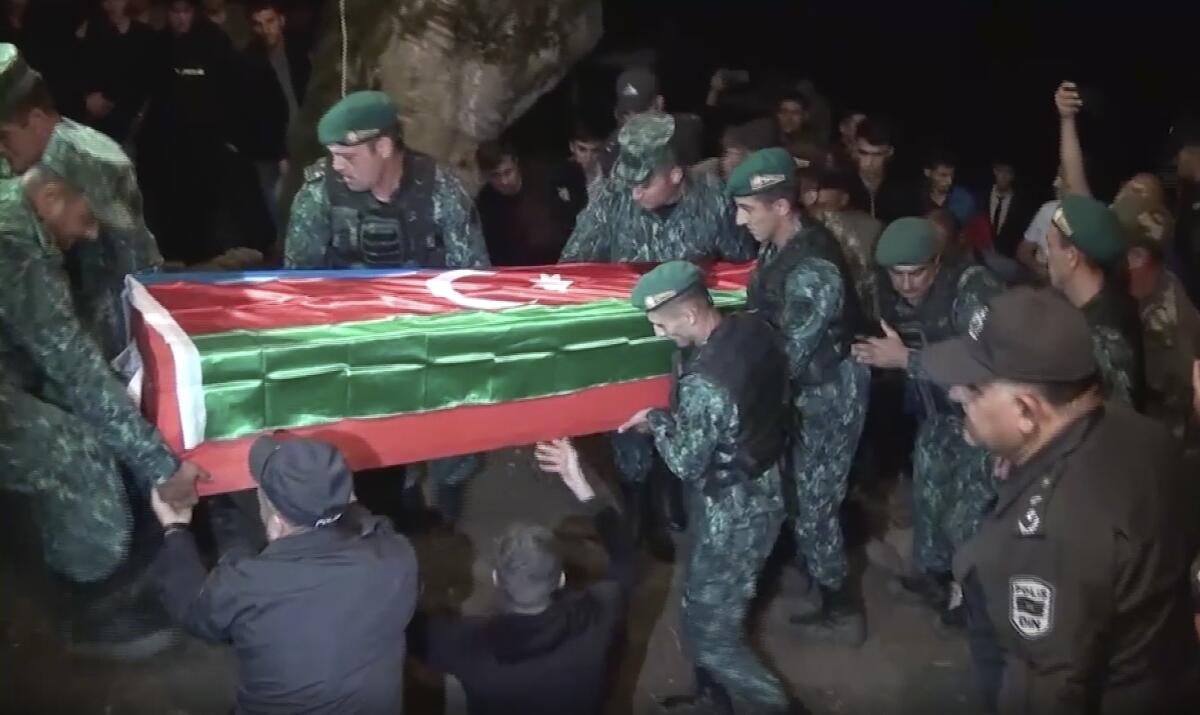Explainer: Fears over festering Armenia-Azerbaijan territorial dispute

- Share via
WASHINGTON — Fearing that the violence could spiral out of control, U.S. Secretary of State Antony J. Blinken recently took the unusual step of seeking to mediate the festering conflict between Armenia and Azerbaijan.
One analyst has called the longstanding and complicated Eurasian dispute the most serious armed struggle that many Americans have never heard of.
The two former Soviet republics in the South Caucasus have long disputed the landlocked region known as the Nagorno-Karabakh. It lies geographically within the borders of Azerbaijan but is mostly populated by ethnic Armenians and controlled by pro-Armenia separatists, who refer to it as Artsakh.
In some respects, that scenario is notoriously familiar in many parts of the world, especially in Europe after the fall of the Soviet Union in 1991. Other examples include the Balkans as Yugoslavia splintered in the mid 1990s and the battle raging today in Ukraine.
The Nagorno-Karabakh conflict is also a war in which each country’s alliances have been shape-shifting, with both Armenia and Azerbaijan at times supported by Russia while Armenia has enjoyed more backing from the U.S., especially among lawmakers who have long sympathized with Armenian American constituents.
A truce between Armenian and Azerbaijani troops appears to be holding following two days of fighting that killed 176 soldiers.
Yet Armenia also counts on Russia as a military ally, while the West is enlisting Azerbaijan’s energy supplies as an alternative to Russian fuel.
The history
Nagorno-Karabakh is historically a predominantly ethnic Armenian enclave but has been internationally recognized as part of Azerbaijan since the two countries gained independence from the fallen Soviet Union.
The two nations that lie along the crossroads of Asia and Europe clashed over the enclave well into the 1990s, in warfare that resulted in 30,000 deaths and the displacement of a million more people. Armenians gained control of Nagorno-Karabakh and several nearby regions.
Tensions never subsided, and in 2020, a six-week war erupted in which 6,600 people were killed.
This time, Azerbaijan, backed by Turkey, retook significant amounts of territory. Pro-Armenian authorities continued to run part of the enclave, which was patrolled by Russian peacekeepers. This rendered Armenia reliant on Moscow for protection.
Most recent fighting
Last month, fighting broke out again. On Sept. 13, some 200 troops and others from both countries were killed in 48 hours, their governments said. A hasty ceasefire was brokered by Russia, with a major assist from the U.N., but it remains fragile.
Each side has accused the other of triggering the violence through “provocative” actions, which reports said expanded fighting from the disputed enclave to farther along the Armenia-Azerbaijan border.
The Armenian Defense Ministry said Azerbaijani forces unleashed an artillery barrage and drone attacks on Armenian territory. Azerbaijan’s Foreign Ministry said it was countering Armenian troops who were planting mines and firing on Azerbaijani military positions.
If it was Azerbaijan that launched this latest series of attacks, Baku may have been taking advantage of Russia being mired in Ukraine and less able or willing to defend Armenia.
Roles for Russia, U.S. grow complicated — as do prospects for durable peace
Each round of fighting has empowered Azerbaijan, analysts say. The nation has emerged “having enhanced its position and demonstrated its battlefield dominance,” the International Crisis Group said in a report Wednesday.
Meanwhile its geopolitical position is also stronger, the report noted. Armenia’s main protector, Russia, is struggling to hold its own in Ukraine since it launched its February invasion, while European capitals crave Azerbaijan’s energy exports, the group said.
An emboldened Azerbaijan may be less willing to seek a diplomatic solution to a conflict generations old. Yet a war that spills over into neighboring regions might harm the economic prospects that Baku may be eyeing.
U.S. congressional support for Armenia unfazed
In a sign of the support Armenia continues to find in the U.S. Congress, regardless of the shifting dynamics, House Speaker Nancy Pelosi traveled to the capital, Yerevan, only days after the latest fighting.
She was accompanied by California Reps. Jackie Speier and Anna G. Eshoo, greeted with flowers from her Armenian counterpart as she arrived, met with Prime Minister Nikol Pashinyan and pledged “the strong and ongoing support of the United States.” She condemned Azerbaijan’s “illegal and deadly” attacks.
Separately, top members of the Senate Foreign Relations committee demanded that the Biden administration halt security aid to Azerbaijan. In a bipartisan resolution, the committee’s chair, Sen. Bob Menendez (D-N.J.), and Sen. Marco Rubio (R-Fla.) also criticized Azerbaijan’s “illegal and unprovoked assault on Armenian territory.”
Blinken’s efforts
The Biden administration, at least publicly, has attempted to remain more impartial.
On the margins of last month’s United Nations General Assembly, the massive annual gathering of most of the world’s leaders, Blinken added a session to his busy schedule on Sept. 19: a joint meeting with Armenian Foreign Minister Ararat Mirzoyan and his Azerbaijani counterpart, Jeyhun Bayramov.
“Strong, sustained diplomatic engagement is the best path for everyone,” Blinken said before the meeting, seated at a head table with the grim-faced Armenians and Azerbaijanis on either side. “There is no military solution to the differences between Armenia and Azerbaijan. But there is, I think, a path to a durable peace that resolves the differences through diplomacy. The United States is prepared to do whatever it can to support these efforts.”
Although Azerbaijan’s Bayramov later sought to minimize the significance of the session, it was the first face-to-face encounter by officials from the two countries since the last round of fighting, and may signal a deeper U.S. involvement to prevent runaway violence.
More to Read
Sign up for Essential California
The most important California stories and recommendations in your inbox every morning.
You may occasionally receive promotional content from the Los Angeles Times.















